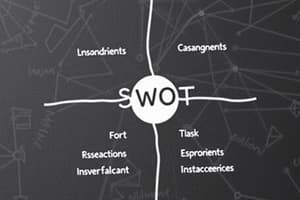Podcast
Questions and Answers
A company is considering entering a new market. Which strategic analysis framework would be MOST suitable for evaluating the external factors influencing this decision?
A company is considering entering a new market. Which strategic analysis framework would be MOST suitable for evaluating the external factors influencing this decision?
- PESTLE Analysis (correct)
- SWOT Analysis
- BCG Matrix
- Porter's Five Forces
A business unit within a large corporation has high market share in a low-growth market. According to the BCG Matrix, how would this unit be classified?
A business unit within a large corporation has high market share in a low-growth market. According to the BCG Matrix, how would this unit be classified?
- Question Mark
- Cash Cow (correct)
- Dog
- Star
Which primary activity in the Value Chain directly involves the movement of finished goods to the customer?
Which primary activity in the Value Chain directly involves the movement of finished goods to the customer?
- Outbound Logistics (correct)
- Inbound Logistics
- Marketing and Sales
- Operations
An organization aims to improve its operational efficiency and agility. Which decision-making framework would best support this goal?
An organization aims to improve its operational efficiency and agility. Which decision-making framework would best support this goal?
A startup is launching a new product and wants to quickly validate its assumptions about customer preferences. Which innovation framework is most suitable for this purpose?
A startup is launching a new product and wants to quickly validate its assumptions about customer preferences. Which innovation framework is most suitable for this purpose?
In project management, which framework is characterized by its linear, sequential approach where each phase is completed before moving to the next?
In project management, which framework is characterized by its linear, sequential approach where each phase is completed before moving to the next?
An organization with diverse product lines and customer segments is considering restructuring. Which organizational structure would be MOST appropriate?
An organization with diverse product lines and customer segments is considering restructuring. Which organizational structure would be MOST appropriate?
A company wants to assess its ability to meet its short-term financial obligations. Which type of ratio should they primarily focus on?
A company wants to assess its ability to meet its short-term financial obligations. Which type of ratio should they primarily focus on?
A marketing team aims to create a consistent brand message across all channels. Which element of the 4Ps of Marketing should they MOST directly address?
A marketing team aims to create a consistent brand message across all channels. Which element of the 4Ps of Marketing should they MOST directly address?
What is the primary goal of the 'Unfreeze' stage in Lewin's Change Management Model?
What is the primary goal of the 'Unfreeze' stage in Lewin's Change Management Model?
An organization identifies two potential growth strategies: selling existing products in new markets and selling new products in existing markets. According to the Ansoff Matrix, these strategies are known as:
An organization identifies two potential growth strategies: selling existing products in new markets and selling new products in existing markets. According to the Ansoff Matrix, these strategies are known as:
Which financial analysis framework is MOST appropriate for valuing an investment based on its expected future cash flows, considering the time value of money?
Which financial analysis framework is MOST appropriate for valuing an investment based on its expected future cash flows, considering the time value of money?
In the ADKAR model for change management, what does the 'K' stand for?
In the ADKAR model for change management, what does the 'K' stand for?
A company is facing increased competition and wants to create a completely new market space, rather than competing in the existing one. Which strategy formulation framework would be MOST appropriate?
A company is facing increased competition and wants to create a completely new market space, rather than competing in the existing one. Which strategy formulation framework would be MOST appropriate?
A project team needs to identify the sequence of activities that determines the shortest possible project duration. Which project management framework should they use?
A project team needs to identify the sequence of activities that determines the shortest possible project duration. Which project management framework should they use?
Flashcards
Business Frameworks
Business Frameworks
Structures that help organizations analyze, plan, and execute strategies effectively.
SWOT Analysis
SWOT Analysis
Evaluates Strengths, Weaknesses, Opportunities, and Threats.
Porter's Five Forces
Porter's Five Forces
Analyzes competitive intensity within an industry.
PESTLE Analysis
PESTLE Analysis
Signup and view all the flashcards
Ansoff Matrix
Ansoff Matrix
Signup and view all the flashcards
BCG Matrix
BCG Matrix
Signup and view all the flashcards
Value Chain Analysis
Value Chain Analysis
Signup and view all the flashcards
Blue Ocean Strategy
Blue Ocean Strategy
Signup and view all the flashcards
Decision Matrix
Decision Matrix
Signup and view all the flashcards
Cost-Benefit Analysis
Cost-Benefit Analysis
Signup and view all the flashcards
OODA Loop
OODA Loop
Signup and view all the flashcards
Design Thinking
Design Thinking
Signup and view all the flashcards
Lean Startup
Lean Startup
Signup and view all the flashcards
Stage-Gate Model
Stage-Gate Model
Signup and view all the flashcards
Waterfall (Project Management)
Waterfall (Project Management)
Signup and view all the flashcards
Study Notes
- Business frameworks are structures that help organizations analyze, plan, and execute strategies effectively
- They offer a systematic approach to problem-solving and decision-making
Strategic Analysis Frameworks
- SWOT Analysis: Evaluates Strengths, Weaknesses, Opportunities, and Threats to provide a comprehensive view of an organization's strategic position
- Strengths: Internal attributes that give an organization a competitive advantage
- Weaknesses: Internal attributes that put an organization at a disadvantage
- Opportunities: External factors that an organization can exploit to its advantage
- Threats: External factors that can cause trouble for an organization
- Porter's Five Forces: Analyzes the competitive intensity and attractiveness of an industry
- Threat of New Entrants: How easy or difficult it is for new competitors to enter the market
- Bargaining Power of Suppliers: The ability of suppliers to drive up prices
- Bargaining Power of Buyers: The ability of customers to drive down prices
- Threat of Substitute Products or Services: The availability of alternatives
- Rivalry Among Existing Competitors: The intensity of competition among existing firms
- PESTLE Analysis: Examines Political, Economic, Social, Technological, Legal, and Environmental factors that can affect a business
- Political: Government policies, regulations, and political stability
- Economic: Economic growth, interest rates, inflation, and unemployment
- Social: Cultural norms, values, demographics, and lifestyle changes
- Technological: Technological advancements, automation, and research and development
- Legal: Laws and regulations related to employment, consumer protection, and intellectual property
- Environmental: Environmental concerns, sustainability, and regulations
Strategy Formulation Frameworks
- Ansoff Matrix: Helps organizations choose a growth strategy based on products and markets
- Market Penetration: Selling more of existing products in existing markets
- Market Development: Selling existing products in new markets
- Product Development: Selling new products in existing markets
- Diversification: Selling new products in new markets
- BCG Matrix: Classifies business units or products based on market growth rate and relative market share
- Stars: High market share in high-growth markets; require significant investment
- Cash Cows: High market share in low-growth markets; generate excess cash
- Question Marks: Low market share in high-growth markets; require careful consideration
- Dogs: Low market share in low-growth markets; may be divested
- Value Chain Analysis: Identifies primary and support activities that add value to a product or service
- Primary Activities: Directly involved in creating and delivering a product or service (e.g., inbound logistics, operations, outbound logistics, marketing and sales, service)
- Support Activities: Support the primary activities (e.g., procurement, technology development, human resource management, infrastructure)
- Blue Ocean Strategy: Creating new market spaces where competition is irrelevant
- Focus on creating new demand, rather than competing in existing markets
- Aims to make the competition irrelevant
Decision-Making Frameworks
- Decision Matrix: Evaluates options based on weighted criteria to make informed decisions
- Identify criteria, assign weights, score each option, and calculate the weighted scores
- Cost-Benefit Analysis: Compares the costs and benefits of a decision to determine its feasibility
- Quantifies costs and benefits in monetary terms
- The OODA Loop: Observe, Orient, Decide, Act; a decision-making process that emphasizes agility and adaptability
- Observe: Gather information about the situation
- Orient: Analyze and interpret the information
- Decide: Choose a course of action
- Act: Implement the decision and monitor the results
Innovation Frameworks
- Design Thinking: A human-centered approach to problem-solving that emphasizes empathy, experimentation, and iteration
- Empathize, Define, Ideate, Prototype, Test
- Lean Startup: Emphasizes validated learning, rapid iteration, and customer feedback
- Build-Measure-Learn loop
- Stage-Gate Model: Divides a project into stages with defined deliverables and gate reviews to ensure quality and viability
- Stages: Distinct phases of project execution
- Gates: Decision points to assess progress and decide whether to proceed
Project Management Frameworks
- Waterfall: A linear, sequential approach to project management
- Requirements are defined upfront, and each phase is completed before moving to the next
- Agile: An iterative and incremental approach to project management that emphasizes flexibility and collaboration
- Scrum and Kanban are popular agile frameworks
- Critical Path Method (CPM): Identifies the longest sequence of activities that determines the project's duration
- Used to optimize project schedules and resource allocation
Organizational Structure Frameworks
- Functional Structure: Organizes departments based on specialized functions (e.g., marketing, finance, operations)
- Suited for stable environments
- Divisional Structure: Organizes departments based on product lines, geographic regions, or customer segments
- Suited for diverse organizations
- Matrix Structure: Combines functional and divisional structures, creating cross-functional teams
- Can improve communication and collaboration but may lead to conflicts
- Network Structure: A decentralized structure that relies on external partners and alliances
- Suited for dynamic and global environments
Marketing Frameworks
- 4Ps of Marketing: Product, Price, Place, Promotion
- Product: Features, benefits, and quality of the offering
- Price: Pricing strategy and tactics
- Place: Distribution channels and availability
- Promotion: Advertising, public relations, and sales promotion
- Marketing Funnel (AIDA): Awareness, Interest, Desire, Action
- A model that describes the stages a customer goes through when making a purchase
- Customer Relationship Management (CRM): Strategies and technologies used to manage and analyze customer interactions and data
- Aims to improve customer satisfaction and loyalty
Financial Analysis Frameworks
- Ratio Analysis: Evaluating financial performance using key ratios (e.g., profitability, liquidity, solvency)
- Profitability ratios: Measure a company's ability to generate profits
- Liquidity ratios: Measure a company's ability to meet short-term obligations
- Solvency ratios: Measure a company's ability to meet long-term obligations
- Discounted Cash Flow (DCF): Valuing an investment based on its expected future cash flows
- Considers the time value of money
- Break-Even Analysis: Determining the point at which total revenue equals total costs
- Helps in pricing and cost management decisions
Change Management Frameworks
- Lewin's Change Management Model: Unfreeze, Change, Refreeze
- Unfreeze: Prepare the organization for change
- Change: Implement the changes
- Refreeze: Reinforce the changes to make them permanent
- Kotter's 8-Step Change Model: Creates a sense of urgency, builds a guiding coalition, forms a strategic vision, enlists a volunteer army, enables action, generates short-term wins, sustains acceleration, and institutes change
- A comprehensive approach to managing organizational change
- ADKAR Model: Awareness, Desire, Knowledge, Ability, Reinforcement
- Focuses on individual change management
Important Considerations
- No single framework is universally applicable; the choice depends on the specific situation and organizational goals
- Frameworks should be adapted and customized to fit the unique context of an organization
- Combining multiple frameworks can provide a more comprehensive and nuanced perspective
- Regular review and refinement of chosen frameworks is essential to ensure their continued relevance and effectiveness
Studying That Suits You
Use AI to generate personalized quizzes and flashcards to suit your learning preferences.




